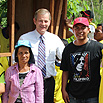Welfare and Self-Reliance Are Rebuilding the Philippines
Contributed By By Kaye Bay, Philippines Area, and Sarah Jane Weaver, Church News assistant editor
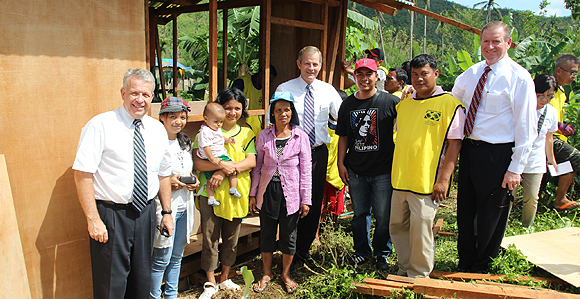
Elder Brent H. Nielson, left, Bishop Gary E. Stevenson, and Gary Porter visit with Philippine storm victims in front of Church-constructed houses.
Article Highlights
- Typhoon Haiyan struck the Philippines on November 8, destroying more than 1.1 million homes and leaving 6,200 dead, 28,000 injured, and 3 million displaced.
- Members are receiving vocational training and learning skills as carpenters, electricians, or plumbers to help construct shelters to house those who lost their homes.
- Church leaders expect that the members’ training and hands-on experience will lead to jobs as the affected region’s infrastructure is rebuilt.
“One of the divinely appointed responsibilities from the Lord is ‘caring for the poor and needy’ while building self-reliance. This is what is special about what is taking place in the Philippines right now. The Church is simultaneously doing this for the people there.” —Bishop Gary E. Stevenson
Related Links
Almost three months after Typhoon Haiyan struck the Philippines, Presiding Bishop Gary E. Stevenson, Philippines Area President Brent H. Nielson of the Seventy, and other leaders visited Church members in Tacloban on January 27 to see how principles of welfare and self-reliance are working in the storm-devastated area.
Their verdict: “Remarkable.”
“One of the divinely appointed responsibilities from the Lord is ‘caring for the poor and needy’ while building self-reliance,” said Bishop Stevenson. “This is what is special about what is taking place in the Philippines right now. The Church is simultaneously doing this for the people there.”
Typhoon Haiyan struck the Philippines on November 8, destroying more than 1.1 million homes. The deadliest typhoon on record in the country, the storm left more than 6,200 people dead, injured 28,000, and displaced 3 million. Some 1,785 people remain missing.
After the disaster, in which 42 Latter-day Saints died, the Church sent relief supplies and partnered with local and international relief organizations to assist with food, shelter, water purification, debris removal, and livelihood restoration projects. To date, Church members have constructed more than 250 shelters, with new homes being completed every day.
Working with the local self-reliance center—an international version of an employment resource center—and with the Perpetual Education Fund, members are receiving vocational training and learning skills as carpenters, electricians, or plumbers. The Church is also helping them obtain basic tools needed to construct shelters to house those who lost their homes during the disaster.
Church leaders expect that the members’ training and hands-on experience will lead to jobs as the affected region’s infrastructure is rebuilt.
“The principles in action right now are quite remarkable,” Bishop Stevenson told the Church News. “We are seeing both the principles of welfare, which is caring for the poor and needy, and the principle of self-reliance in action. This is astounding, and something that will have a far-reaching impact upon Church members.”
Elder Nielson said the highlight of the visit was the opportunity to see welfare and self-reliance come together in a remarkable way.
“Each family is given materials to build a new shelter and tools to assist,” he explained. “The family builds their own home with the assistance of a carpenter and three other members. Once the shelter is built, then the family assists nine other families in building their shelter. At the end of that experience, the family is given the tools to keep and a certificate of carpentry is issued certifying that they have learned basic carpentry skills. They are then able to apply for the many construction jobs that are now available in Tacloban. In the process, the Church helps them help themselves. They help other members and in the process gain a marketable skill.”
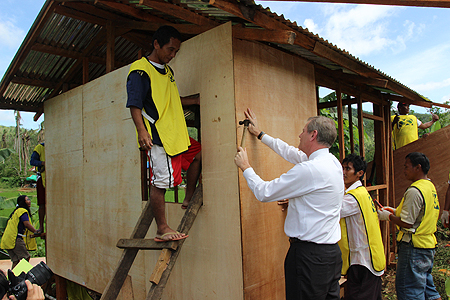
Bishop Gary E. Stevenson lends a hand constructing new houses in Tacloban, Philippines. In coming months the Church will build some 3,000 homes for Church members and others.
Elder Robert C. Gay, chairman of the Church Perpetual Education Fund, expressed support for the self-reliance initiative. He explained, “The work of building shelters in the Philippines is an example of helping the poor and needy in the Lord’s way—welfare relief accompanied by training to help our members acquire longer term work skills that help them lift themselves while working as one under the direction of local priesthood.”
Speaking of Bishop Stevenson’s visit to Tacloban, Elder Nielson said, “He was able to see firsthand the needs of the people and also participate in the work that is being done to assist.”
He also said Bishop Stevenson—who was serving as President of the Church’s Asia North Area when a tsunami struck Sendai, Japan, in 2011 and coordinated the Church’s relief and recovery efforts after the disaster—was able to provide valuable insight gleaned from his experience there.
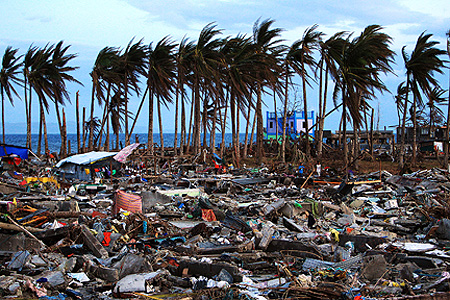
Damage in Tacloban, Tuesday, November 19, 2013, following a typhoon in the Philippines.
“The members and leaders in Tacloban were moved by his visit,” said Elder Nielson. “They understood his role as the Presiding Bishop of the Church in providing for those in need and in directing the work in Tacloban.”
Despite losing so much in the disaster, the members have “smiles on their faces,” Bishop Stevenson said. “They have hope; they have faith. It’s an example for the world. It’s an example for members of the Church everywhere.”
Bishop Stevenson and Elder Nielson were accompanied by Elder Abenir Pajaro, Area Seventy; Gary B. Porter, secretary to the Presiding Bishopric; Todd Tapp, director for temporal affairs for the Philippines Area; and Nate Leishman, manager of emergency response for the Welfare Services Department.
After the visit Bishop Stevenson, Elder Nielson, and Elder Pajaro presided over a leaders’ meeting to answer questions regarding the shelter program of the Church. The leaders assured the members that Heavenly Father loves them and knows each of them.
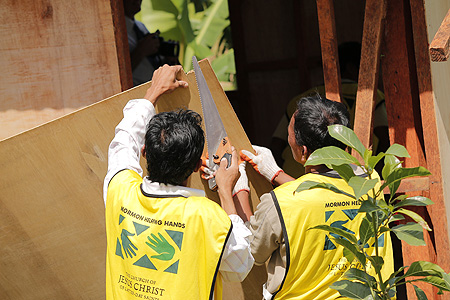
Church members in the Philippines construct new homes.
Quoting Alma 26:37, Bishop Stevenson said Latter-day Saints understand that “God is mindful of every people, whatsoever land they may be in; yea, he numbereth his people, and his bowels of mercy are over all the earth.”
“Our Philippine members have hope now because they see they will have a roof over their head. They are going to help build that themselves. They will have a place for their children to sleep. … This is what we saw and this is what we felt—that the Lord is aware of each and every one of their circumstances.”
